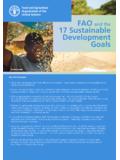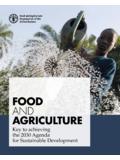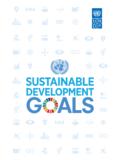Transcription of Health and Sustainable Development - WHO
1 WHO/HDE/ : EnglishHealth and Sustainable Development Key Health TrendsWorld Health OrganizationThis report for the UN Secretary-General was prepared by Y. von Schirnding and C. Mulholland ofWHO (as task manager for Chapter 6 of Agenda 21), with contributions from various departments,UN Agencies and international organizations. The report is a brief factual overview, which is inten-ded to inform the Commission on Sustainable Development on key Health trends. It is not a formal publication of and Sustainable Development Key Health TrendsWorld Health OrganizationPrinciple I of the RioDeclaration on Environmentand Development states that Human beings are at the centre of concerns for Sustainable Development . They are entitled to a healthy and productive life in harmony with nature.
2 The goals of Sustainable Development cannot be achieved when there is a high prevalence of debilitating illnesses, and population Health cannot be maintained without ecologicallysustainable Development . This report examinesprogress achieved in selected areas related to Chapter six of Agenda 21, highlights areas in which progress has been limited, and identifies issues and trends warrantingfuture consideration. Health issues relatedto other aspects of Sustainable Development are addressed in subsequent reports dealing with the thematic review of Agenda and Sustainable Development Key Health Trends Human beings are at the centre of concerns for Sustainable are entitled to a healthy and productive life in harmony with nature 1|Introduction |3 Over the past decade, average lifeexpectancy has increased, infant and childmortality rates have declined, and theproportion of underweight and stuntedchildren has decreased.
3 In developingcountries, the percentage of people with life expectancy at birth below sixty declinedfrom 38 per cent to 19 per cent between1990 and 1999. The proportion of peoplewithout access to improved water supply fellfrom 21 per cent to 18 per cent over the pastdecade. Many infectious diseaseshave receded, owing to improvedsanitation, nutrition, drugs andvaccines. Notable progress towards theeradication or elimination of variousmajor infectious diseases has beenmade. For example, the annualincidence of polio has fallen from an estimated 350,000 cases in 1988(the start of the Global PolioEradication Initiative), to anestimated maximum of 20,000 in 1999. The number of polio-infected countries fellfrom 125 to 30 over that period; the remaininginfected countries are concentrated in parts of sub-Saharan Africa and the Indiansubcontinent particularly in areas with low routine immunization coverage, poorsanitation or where conflict is prevalent.
4 A marked acceleration of activities has beenundertaken to meet the goal of globaleradication of polio by 2005. Success in the form of a 90 per cent (or higher) reduction in cases of guineaworm over the past decade was achievedowing to a strategy based on healtheducation, case containment and provisionof safe drinking water. Intensified efforts in leprosy control led to a drop in theprevalence rate from per 10,000 in 1990to per 10,000 at the beginning of2000. In West Africa, onchocerciasis (riverblindness) has been virtually eliminated in eleven countries through a programmerelying on vector control and community-based drug treatment, freeing millions ofpeople from infection by the disease andreleasing millions of hectares of riverineland for resettlement and cultivation.
5 Owing to the combined efforts of theWorld Health organization (WHO), theUnited Nations Children s Fund (UNICEF)and other partners, immunization coveragefor diphtheria, pertussis and tetanus (DPT),tuberculosis, measles and polio is currently80 per cent or more in a majority of countries, as compared to approximately30 per cent twenty years ago. Health and Sustainable Development Key Health Trends4|2|Steady Gains in Global HealthDespite undoubted healthadvances in many areas, poorhealth continues to be a constraint on developmentefforts. In some cases theprocess of Development itself is creating conditions where, as a result of economic, politicaland social upheaval,environmental degradation, and uneven Development orincreasing inequities, human Health suffers.
6 The facts below are than 200 million peoplelive today in countries with an average life expectancy ofless than 45 years. Average lifeexpectancy at birth in 1999 was years in the leastdeveloped countries, compared to for all developing countries and fordeveloped countries. In many sub-SaharanAfrican countries, life expectancy fell duringthe 1990s owing to the impact ofHIV/AIDS. Other major setbacks in healthgains occurred in Eastern Europe and theformer Soviet Union, where the politicaland economic transition has beenaccompanied by decreases in life expectancy of five yearsfor some of the poorestcountries of the world , one in five children still fails to reach his or her fifth birthday, mainlyowing to infectious diseases related to theenvironment.
7 The child mortality rate in the least developed countries in 1999 was156 per 1,000 live births, compared to 81 in all developing countries and 11indeveloped countries. Health and Sustainable Development Key Health Trends|5 Least-Developed CountriesOther Low-Income CountriesLower-Middle-Income CountriesUpper-Middle-Income CountriesHigh-Income CountriesSub-Saharan AfricaSource: WHO, Macroeconomics and Health : Investing in Health for Economic Development . Report of the Commission on Macroeconomics and Health , CategoryPopulation (1999 millions)Annual Average Income(US dollars)Life Expectancyat Birth (years)Infant Mortality(deaths before age 1 per 1,000 live births)Under FiveMortality (deaths before age 5 per 1,000live births)Life Expectancy And Mortality Rates, By Country Development Category (1995-2000)643296511001591,7775385980120 2,0941,2007035395734,90071263589125,7307 86664250051921513|Gaps and constraintsDespite undoubted Health advances in many areas, poorhealth continues to be a constraint on Development effortsMore than 20 million women continue toexperience ill Health each year as a result ofpregnancy.
8 The lives of eight million ofthese women are threatened by serioushealth problems, and about 500,000women, almost 90 per cent of whom are inAfrica and Asia, die as a result of causesrelated to pregnancy andchildbirth. Around 17 per centof potentially healthy years oflife are lost in women ofreproductive age because ofsexually transmitted diseases,including HIV/AIDS. Factors that hamper progress includeinequalities in access to information and to Health services, prevalence of high-risksexual behaviour, and the low social statusof women. WHO s Making PregnancySafer strategy will contribute toworldwide efforts to reducematernal and perinatalmortality. Efforts are also beingintensified to improvewomen s Health in general, focusing, interalia, on the Health implications of harmfulpractices on the girl child and thepromotion of women s Health throughfunctional literacy and economic and parasitic diseases(communicable diseases) account for 14 million deaths per year, around 25 percent of the world total.
9 They are theworld s leading killers of children andyoung adults, including manybreadwinners and parents. Thesediseases, which have intimate links toenvironmental conditions and poverty,affect the lives of poor peopledisproportionately and pose a seriousthreat to Health and economicdevelopment. Six major diseases currently cause 90 percent of the deaths from communicablediseases: AIDS, malaria, tuberculosis,pneumonia, diarrhoealdiseases, and measles. In addition, several parasiticconditions continue to causeconsiderable morbidity anddisability: schistosomiasis (over 200 million peopleinfected), lymphatic filariasis (120 millionpeople affected), trachoma (over 150 millioninfected), trypanosomiasis, or sleepingsickness (over 55 million people threatened),and Chagas disease (up to 18 million peopleinfected in Latin America).
10 HIV/AIDS has reversed therising life expectancies of the1990s (sometimes to pre-1980levels) in some countries. It is the fastest growing Health threat to Development today and a potential risk to security. About 40 million adults andchildren are now living with HIV/AIDS, 95 per cent of them in developingcountries. In sub-Saharan Africa, over 25million people are infected with than 12 million Africans have died ofAIDS (over two million in a single year), and many millions have been orphaned,due to HIV/AIDS. High (or rising) HIV infection rates arealso occurring in many other parts of theworld. For example, in Asia, where morethan six million people are living withHealth and Sustainable Development Key Health Trends6|HIV/AIDS is the fastest growinghealth threat to Development todaySix major diseasescurrently cause 90 per cent of the deaths from , there is the potential for anexplosive epidemic.















